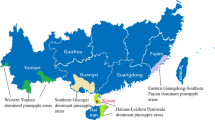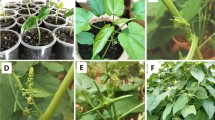Abstract
This study investigated how the ploidy level of the kiwifruit pollinizer cultivars “CK3” (diploid), “T line” (tetraploid), “Pohwa” (hexaploid) and “Chieftain” (hexaploid) affected fruit set, fruit quality, and seed formation in the tetraploid kiwifruit cultivars “Halla Gold” and “Sweet Gold” cultivated in an unheated greenhouse in Jeju, Korea. Pollen tubes growing in the pistil reached and combined with the ovule 3 days after artificial pollination, and their patterns differed depending on the ploidy level of the pollen parent. The number of pollen tubes observed in “Halla Gold” and “Sweet Gold” pistils was significantly lower following pollination by “CK3” than with the other pollen donors. In all pollen treatments, the fruit set rates were > 90%. The fruit weight of both “Halla Gold” and “Sweet Gold” were high following pollination with “Chieftain” and “Pohwa”. The dry matter content, soluble solids, and acidity were not significantly different among all pollination treatments. Fruit firmness was higher following pollination with “Chieftain” and “Powha.” Colorimeter h˚ values for flesh of “Halla Gold” was low following pollination with “CK3,” but there were no differences for “Sweet Gold” among all pollinations. The number of seeds showed a similar trend to fruit weight, but the 100-seed weight was highest with “T line” as the pollinizer. The results indicate that the ploidy level of the pollen donor affects fruit quality more than fruit set. Also, the pollen most suitable for cultivation of “Halla Gold” and “Sweet Gold” is considered to be tetraploid “T line” and hexaploid “Pohwa” and “Chieftain,” which showed favorable effects on the weight and firmness of fruits, and the number and weight of seeds without adversely influencing fruit set and dry matter content.

Similar content being viewed by others
Data availability
All data generated or analysed during this study are included in this published article and its supplementary information files.
References
Burdon J, Pidakala P, Martin P, Billing D, Boldingh H (2016) Fruit maturation and the soluble solids harvest index for ‘Hayward’ kiwifruit. Sci Hortic 213:193–198
Burdon J, Pidakala P, Martin P, Billing D (2017) Softening of ‘Hayward’ kiwifruit on the vine and in storage: the effects of temperature. Sci Hortic 220:176–182
Buxton KN (2005) Preharvest practices affecting postharvest quality of Hayward kiwifruit. PhD thesis, Massey University, Palmerston North, New Zealand, p 297
Cameron JW, Burnett RH (1978) Use of sexual tetraploid seed parents for production of triploid Citrus hybrids. HortScience 13:167–169
Distefano G, Casas GL, Malfa SL, Gentile A, Tribulato E (2009) Pollen tube behavior in different mandarin hybrids. J Am Soc Hortic Sci 134:583–588
Feng J, MacKay BR, Maguire K (2003) Maguire variation in firmness of packed ‘Hayward’ kiwifruit. Acta Hortic 610:211–218
Ferguson AR (1984) Kiwifruit: a botanical review. Hortic Rev 6:1–64
Galimberti P, Marro M, Joss EF, J (1988) Periodo utile d’impollinazione in Actinidia deficiosa. Rivista di Frutticoltura 50:71–74
Gonzàlez MV, Coque M (1995) Stigmatic receptivity limits the effective pollination period in kiwifruit. J Am Soc Hortic Sci 120:199–202
Harvey CF, Fraser LG, Kent J (1991) Actinidia seed development in interspecific crosses. Acta Hortic 297:71–78
Hopping ME (1976) Effect of exogenous auxins, gibberellins, and cytokinins on fruit development in Chinese gooseberry (Acinidia chinensis Planch.). NZ J Bot 14:69–75
Jeong SY, Yi KU, Hyun SW, Kang HH, Song KJ (2018) Effect of pollen donor genotype and dilution ratio on the seed formation and fruit quality in yellow-fleshed kiwifruits. J Korean Soc Int Agric 30(2):1–7
Jerram EM (1979) Pollination of kiwifruit (Actinidia chinensis Planch.): stigma-style structure and pollen tube growth. NZ J Bot 17:233–240
Lawes GS, Woolley DJ, Lai R (1990) Seeds and other factors affecting fruit size in kiwifruit. Acta Hortic 282:257–264
Oh EU, Jeong SY, Kang HH, Song KJ (2020) Characterization of pollen development in staminate kiwifruit (Actinidia sp.) cultivars. Hortic Sci Technol 38:1–8
Pok P, Oh EU, Yi KU, Kang JH, Ko BY, Kim HB, Song KJ (2015) Characterization of microspore development and pollen tube growth response to self- and cross-pollination in Jeju old local citrus species. Hortic Environ Biotechnol 56:225–232
Pyke NB, Alspach PA (1986) Inter-relationships of fruit weight, seed number, and seed weight in kiwifruit. NZ J Agric Sci 20:153–156
Schmid R (1978) Reproductive anatomy of Actinidia chinensis (Actinidiaceae). Bot J Syst Pfl 100:149–195
Seal AG, Dunn JK, Jia YL (2013a) Pollen parent effects on fruit attributes of diploid Actinidia chinensis ‘Hort16A’ kiwifruit. NZ J Crop Hortic Sci 41:219–229
Seal AG, Dunn JK, Silva HND, McGhie TK, Lunken RCM (2013b) Choice of pollen parent affects red flesh color in seedlings of diploid Actinidia chinensis (kiwifruit). NZ J Crop Hortic Sci 41:207–218
Seal A, McGhie T, Boldingh H, Rees J, Blackmore A, Jaksons P, Machin T (2016) The effect of pollen donor on fruit weight, seed weight and red colour development in Actinidia chinensis ‘Hort22D.’ NZ J Crop Hortic Sci 44:1–12
Stasiak A, Latocha P, Drzewiecki J, Hallmann E, Najman K, Leontowiez H, Leontowicz M, Lata B (2019) The choice of female or male parent affects some biochemical characteristics of fruit or seed of kiwiberry (Actinidia arguta). Euphytica 215:52
Yang HB, Lee SC, Kim SL, Lee MS, Lee JH, Kim TC, Kim YG, Song KJ (2008) Fertilization and seed formation by artificial pollination of tea (Camellia sinensis). J Korean Tea Soc 14(2):169–176
Acknowledgements
This study was funded by the Industry-Academia-Research Institute Collaboration Expansion Project Grant (Jeju Kiwi Cooperation Group) of the Collaboration Project for Regional Strategic Plants from the Rural Development Administration.
Author information
Authors and Affiliations
Contributions
Conceived and designed of the experiments: KJS, EUO. Performed the experiments: EUO, SYJ, JYK. Analyzed the data: EUO. Wrote the paper: KJS, EUO.
Corresponding author
Ethics declarations
Conflict of interest
Authors declare that none of the authors have any competing interests in the manuscript.
Additional information
Communicated by Heakeun Yun, Ph.D.
Publisher's Note
Springer Nature remains neutral with regard to jurisdictional claims in published maps and institutional affiliations.
Rights and permissions
About this article
Cite this article
Oh, E.U., Jeong, S.Y., Kim, J.Y. et al. Response of fruit set and quality and seed formation to ploidy levels of pollen donor in yellow-fleshed kiwifruits. Hortic. Environ. Biotechnol. 62, 9–15 (2021). https://doi.org/10.1007/s13580-020-00293-z
Received:
Revised:
Accepted:
Published:
Issue Date:
DOI: https://doi.org/10.1007/s13580-020-00293-z




